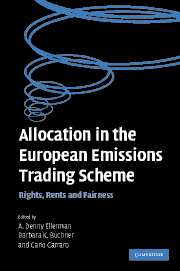Book contents
- Frontmatter
- Contents
- List of figures
- List of boxes
- List of tables
- List of contributors
- Introductory note/Foreword
- Acknowledgements
- Glossary and abbreviations
- Part I The EU ETS allocation process
- Part II Experiences from Member States in allocating allowances
- 3 United Kingdom
- 4 Germany
- 5 Denmark
- 6 Sweden
- 7 lreland
- 8 Spain
- 9 Italy
- 10 Hungary
- 11 Czech Republic
- 12 Poland
- Part III Concluding remarks and background material
- Appendix I Participants
- Appendix II The individual country outlines
- Appendix III The country tables
- Appendix IV Background material from the European Commission
- Index
3 - United Kingdom
Published online by Cambridge University Press: 22 September 2009
- Frontmatter
- Contents
- List of figures
- List of boxes
- List of tables
- List of contributors
- Introductory note/Foreword
- Acknowledgements
- Glossary and abbreviations
- Part I The EU ETS allocation process
- Part II Experiences from Member States in allocating allowances
- 3 United Kingdom
- 4 Germany
- 5 Denmark
- 6 Sweden
- 7 lreland
- 8 Spain
- 9 Italy
- 10 Hungary
- 11 Czech Republic
- 12 Poland
- Part III Concluding remarks and background material
- Appendix I Participants
- Appendix II The individual country outlines
- Appendix III The country tables
- Appendix IV Background material from the European Commission
- Index
Summary
Background and overview
The United Kingdom's Phase 1 National Allocation Plan (NAP) was the first to be published in draft form and it was therefore one of the most influential of the twenty-five Member State plans developed to implement the EU ETS. The UK has made climate change a public policy priority and it had already implemented various policy measures to reduce emissions of greenhouse gases (GHG), including a smaller Emissions Trading Scheme (UK ETS). The UK experience provides insights into the complex issues involved in translating the need to allocate allowances under a cap-and-trade programme into a practical and workable allocation programme.
Background on UK emissions and climate policies
In 2003, GHG emission sources in the UK were responsible for around 655 Mt CO2 equivalents (of which 556 Mt, or 85%, was CO2), making it the second largest emitter of GHGs in Europe. The European Burden-Sharing Agreement (BSA) commits the UK to reducing emissions of all six Kyoto GHGs by 12.5% below its 1990 emissions by the first Kyoto commitment period. In addition to its international commitments, the UK has set for itself a more demanding national target for 2010 to reduce emissions of CO2 alone by 20% below 1990 levels, and to put itself ‘on a path towards’ a 60% reduction in CO2 emissions by 2050 (Department of Trade and Industry 2003).
During the 1990s, the UK significantly reduced its GHG emissions. A major factor contributing to this development was substantial fuels-witching in the electric power sector from coal-fired to gas-fired generation.
- Type
- Chapter
- Information
- Allocation in the European Emissions Trading SchemeRights, Rents and Fairness, pp. 41 - 71Publisher: Cambridge University PressPrint publication year: 2007
- 4
- Cited by



